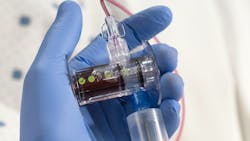Stanford Health Care study finds zero blood culture contaminations and false-positive CLABSIs
The "Getting to Zero, Eliminating Blood Culture Contamination with the ISDD" presented at IDWeek 2020, the annual conference of Infectious Disease Society of America (IDSA), reported zero blood culture contamination events (0.0 percent contamination rate) and zero false-positive CLABSIs out of 4,462 blood cultures drawn with the Steripath Gen2 Initial Specimen Diversion Device (ISDD) during a four-month study, versus 29 contaminated sets in 922 blood cultures using traditional methods (3.15 percent contamination rate), announced Magnolia Medical Technologies.
Lucy S. Tompkins, MD, PhD, a professor and physician at Stanford Health Care (Lucy Becker Professor of Medicine – Infectious Diseases, and of Microbiology and Immunology, Stanford University School of Medicine, Hospital Epidemiologist and Medical Director, Infection Prevention & Control at Stanford Health Care), presented an oral abstract of the Steripath Gen2 ISDD from Magnolia Medical Technologies, Inc., from study results evaluating the impact of Steripath in reducing false-positive blood culture results for sepsis testing.
The study concluded that adoption of Steripath Gen2 ISDD led to a substantial decrease in contaminated blood cultures and false-positive CLABSIs, which can impact inappropriate antibiotic usage, improve correct diagnoses, minimize patient discomfort, and reduce hospital-acquired infections related to longer stays – all of which improve patient safety and outcomes.
"Blood culture contamination is a serious patient safety issue and is associated with several harmful outcomes," said Dr. Tompkins. "Even though Stanford Hospital has a superb phlebotomy team, our team could not always reduce the contamination rate to below three percent, the current industry 'standard'. When using the Steripath Gen2 ISDD on in-patients and ED patients, many of whom are 'hard sticks', our team was able to reduce the contamination rate to zero over the course of a four-month clinical trial."
"Our results confirm those of Dr. Mark Rupp whose seminal Steripath ISDD study clearly demonstrated that the ISDD is the most effective way to reduce, and even eliminate, blood culture contamination," added Dr. Tompkins.
Dr. Tompkins went on to say, "Along with many other hospital epidemiologists, I did not initially believe we could reduce CLABSIs to zero. With many changes in practice and policies, it is quite clear that the goal of zero CLABSIs can be achieved. As a result of our experience with the Steripath Gen2, we join others in promoting the goal to establish a new standard of zero for blood culture contamination."
The outcomes of this study resulted in Stanford hospital adopting the Steripath Gen2 ISDD for phlebotomy use hospital-wide.
The patented Steripath Gen2 ISDD product portfolio, including both direct-to-media and syringe configurations, are the only FDA 510(k)-cleared devices indicated to reduce blood culture contamination. This indication was cleared by the FDA based on peer-reviewed published controlled clinical studies demonstrating Steripath's ability to reduce blood culture contamination by 83 percent and 88 percent.
The Steripath Gen2 platform integrates user-controlled negative pressure to divert and sequester the initial 1.5 to 2.0 mL of blood collected for culture, the portion known to most likely contain contaminants. The device has been clinically proven effective for use with blood cultures drawn via both venipuncture and peripheral IV starts.
Steripath addresses a significant hidden problem in healthcare: the misdiagnosis of sepsis. Improving the accuracy of diagnostic test results for sepsis can reduce unnecessary antibiotic treatment. This helps to address the growing threat of antibiotic-resistance, decreases hospital length of stay and associated healthcare-acquired infections while significantly reducing avoidable hospital costs.
